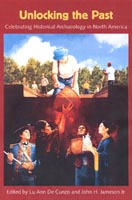Mining the West
By
R. Scott Baxter and Rebecca Allen

The Buena Vista Pump House, built in 1882 at New Almaden Quicksilver Mines, California. Photograph courtesy of the New Almaden Mining Museum, taken in the late 1880s.
Recently, a University of Nevada Field School project took a more in-depth look at the miners living on one lot in Virginia City, Nevada. In the 1880s, O'Brien and Costello's Saloon and Shooting Gallery stood on the lot. Virginia City was established in the 1850s by miners in pursuit of gold and silver. It became the heart of the famous "Comstock," at its peak boasting a population of twenty thousand people. Situated in Virginia City's infamous "Barbary Coast," O'Brien and Costello's primarily served a working-class clientele of Irish descent. The archaeologists sought answers to research questions about Irish ethnicity and consumer practices, including the potentially lethal combination of alcohol and firearms. Using a combination of heavy equipment to define site stratigraphy and careful hand excavation to separate materials from various layers, the archaeological team uncovered a variety of domestic and saloon related materials.
Historic maps, claim records, and newspaper accounts all indicate where we may find specific archaeological features. The town of New Almaden still exists, and many longtime residents have had oral and written traditions handed down to them over the years. They remember active mining at the New Almaden, or have parents, grandparents, and great-grandparents who were miners. Many were miners themselves, and they know the holdings of the local museum. The current task is to study the ground, study the archival record, and to identify and interview local people. Our goal is to capture these various pieces of knowledge, order them into a chronology, locate them on a map, and link them with on-the-ground features. Future studies will focus on the miners, their families, and the development of mining technologies.
These examples demonstrate how historical archaeologists' studies of mining in the West offer insight into the development of an industry and a people during periods of great change. These studies also promise glimpses of how miners adapted their lifestyles and technologies to different environments, and how they ultimately shaped those environments. Both of these topics hold relevance as we ponder a world whose resources no longer seem limitless. We must understand the past and future consequences of exploiting our natural resources.
R. Scott Baxter is historical archaeologist at Past Forward, Inc. and Rebecca Allen is President of Past Forward, Inc.
